Iran–Iraq War
![]()
The title of this article is ambiguous. For the war between Iraq and Kuwait 1990-1991, sometimes counted as the First Gulf War, see Second Gulf War.
First Gulf War
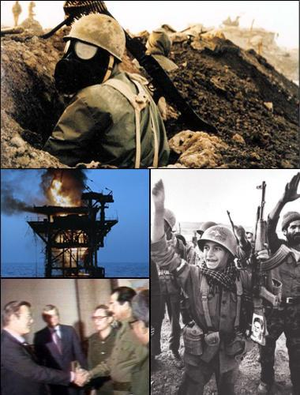
First Gulf War
Iraqi Invasion (1980)
Entegham - Kaman 99 - Khorramshahr - Sultan 10 - Scorch Sword - Abadan - Kafka - Ashkan - Morwarid - Dezful.
Stalemate (1981)
Tavakol - Susangerd - H-3
Iranian offensives for the liberation of Iranian territory (1981-82)
Samen-ol-A'emeh - Tariq al-Qods - Fath ol-Mobin - Beit ol-Moqaddas - Liberation of Khorramshahr
Iranian offensives in Iraq (1982-84)
Ramadan - Moslem Ibn Aqil - Muharram ol-Harram - Dawn 1 - Dawn 2 - Dawn 3 - Dawn 4 - Dawn 5 - Kheibar - Kurdish uprising - Dawn 6 - Dawn 7 - Hawiza Marsh
Iranian offensives in Iraq (1985-87)
Badr - Dawn 8 - 1st al-Faw - Dawn 9 - Karbala 1 - Karbala 2 - Karbala 3 - Fath 1 - Karbala 4 - Karbala 5 - Karbala 6 - Karbala 7 - Karbala 8 - Karbala 9 - Karbala10 - Nasr 4
Last year of war (1988)
Beit ol-Moqaddas 2 - Anfal - Halabja - Zafar 7 - Tawakalna ala Allah - 2nd al-Faw - Shining Sun - 40 Stars - Mersad
Tanker War
Earnest Will - Prime Chance - Eager Glacier - Nimble Archer - Praying Mantis
International incidentsUSS
Stark - Iran Air Flight 655
The First Gulf War was a war between Iraq and Iran that lasted from September 22, 1980 to August 20, 1988 (also known as the Iran-Iraq War or Iraq-Iran War; as distinct from the Iraq-Kuwait War, the Second Gulf War).
It ended in an armistice after high human and economic losses on both sides without a winner.
War History
Iraqi attack
1980
On September 22, 1980, at 2 p.m. local time, the war began with massive air strikes against the airports of the Iranian cities of Tehran, Tabriz, Kermānschāh, Ahvaz, Hamadan, and Dezful. At the same time, the Iraqi army advanced with a total of 100,000 men at three points into the oil and gas-rich province of Khuzestan.
The Iraqi war plan was based on plans from a British staff exercise in 1941 for the invasion of Khuzestan by a division. The plan called for the invasion with nine divisions. Three armored and two mechanized divisions were to take the province and eventually secure the passes over the Zagros Mountains. Three infantry and one armored division were to intercept a possible Iranian counterattack on the northern flank, similar to the approach of the Anglo-Soviet invasion of 1941. The war plan called for the completion of operations after two weeks.
Although massive terrain gains were recorded after six days, it was not until 24 October that the city directly on the Shatt al-Arab could be taken after the Battle of Khorramshahr. Fighting was also opened on the northern border, but the main thrust was aimed at Khuzestan province. The war was designed as a blitzkrieg; documents found among Iraqi officers in particular show a planned combat duration of no more than fourteen days (Henner Fürtig: Der irakisch-iranische Krieg, p. 62). By the end of 1980, the Iraqi army had achieved a terrain gain of 14,000 km².
For the failure of the offensive, Fürtig analyzes on the Iraqi side "the withholding of certain troop units to protect Baghdad, the unexpected resistance of the Arab Iranians, and hesitant Iraqi action." (Fürtig, p. 69). The Iranian side was able to deploy just under 110,000 of its regular forces, leaving only a quarter of its forces, a maximum of 120 armored vehicles, and fifty percent of its combat aircraft. This shortage could be compensated for by increasing the personnel of the regular armed forces by more than 200,000 Pasdaran, who lacked military training but did not lack the will to fight. It is possible that Saddam Hussein had already recognized the military situation by the end of 1980 and, with his declaration of a neutral zone on December 25, 1980, had indicated the anticipation of the hopelessness of further warfare. With terrain gains over a length of 600 km, but only 20 to 80 km deep in Iranian territory, it was no longer possible to speak of a blitzkrieg.
By the end of 1980, more than 20,000 dead Iraqi and Iranian soldiers had been counted.
1981
Iran's first major counteroffensive of 400 tanks resulted in the Tank Battle of Susangerd on January 5-11. In the process, 50 Iraqi and 140 Iranian tanks were destroyed. The night attack in Operation Nasr on March 19 was carried out with 100,000 Iranian fighters, including 30,000 Pasdaran and volunteers. The Iraqi army lost 700 armored vehicles in these battles, 10,000 soldiers died, 25,000 wounded were recorded, and 15,000 were taken prisoner. The Iranian army leadership shifted attacks to night time, as the Iraqi air force did not fly night missions.
On September 29, 1981, a Lockheed C-130 of the Iranian Air Force crashed on its way back from the front with the entire top of the army. General Walliollah Fallahi, Chief of Staff of the Iranian Armed Forces, Defense Minister Colonel Musa Namju and his predecessor Colonel Jawad Fakuri were among the dead. The plane reportedly caught fire and crashed. The commission of inquiry failed to reach a final report, leaving the question of sabotage unresolved to this day. Fallahi is said to have been the first to admit unreservedly that the war could not have been won without American arms supplies. Fallahi was succeeded as commander-in-chief of the army by Ali Seyyed Shirazi, who was to be responsible for the success of the 1982 spring offensive and for pushing the Iraqis back from Iranian territory. Nevertheless, the original war of movement now became a war of position, with Iranian troops running en masse against Iraqi positions.
In the course of the war, the tactics of the war increasingly resembled those of World War I, with wave attacks on the Iranian side and trench systems on both sides (see trench warfare). The extensive use of minors in Iranian volunteer units (Basij), who were deployed with limpet mines in anti-tank operations, among other things, also caused outrage and horror, especially among the Western public.
Iranian offensive
1982
On March 27, the offensive against Iraq began, and on April 29, fighting began in the Howeiza area, with 12,000 to 15,000 Iraqi soldiers taken prisoner. By this time, the Iraqi side counted between 60,000 and 100,000 soldiers killed and wounded and 50,000 taken prisoner. On May 24, Khorramshahr was retaken with the participation of about 70,000 Iranians, and on July 13, Iranian troops crossed the border into Iraq for the first time. On September 30, the first wave attack with Basiji volunteers took place near Mandali, killing 4000 Iranians.
On June 20, 1982, Saddam Hussein announced a unilateral ceasefire, but Ayatollah Ruhollah Khomeini rejected it. Thereafter, information about Iranian troop movements, weak points, and possible offensives was allegedly transmitted to Iraq by the U.S. government through Saudi Arabia. Why Iran rejected a ceasefire can be seen in the changing Iranian war aims. At the beginning of the war, it was about defending the country; from mid-1982, it was about conquering Iraq and exporting revolution.
"There is no reason to end the war. [...] Iraq must be occupied or our revolution is doomed to failure."
- Ruhollah Khomeini.
"If we cash in on Iraq, our two countries will be one, and the largest oil producer in the world. Together we would be nearly 60 million Muslims and have tremendous power over the world economy. Saudi Arabia, along with its American allies, would be paralyzed, and the Gulf states would fall into our laps like ripe grapes."
- Akbar Hāschemi Rafsanjāni.
"I, spokesman for the nation, who have the confidence of the people, say to you: the war will go on to the last drop of blood."
- Ali Khamene'i on September 28, 1982.
In September 1982, Saudi Arabia feared Iran's dominance against Iraq and put forward a peace plan that would have awarded Iran reparations of $70 billion. Iraq supported this plan, but it was labeled blood money and rejected by the Iranian side. Rather, Iran's offensive pursuit was aimed at "liberating" the holy Shiite sites of Karbala and Najaf. The war escalated increasingly and bombardments of refineries and loading stations were intended on both sides to weaken the opponent economically as well.
1983
The Iranians' spring offensive resulted in the capture of 250 square kilometers of Iraqi territory. Operation Dawn 1 began on April 10, Operation Dawn 2 in the central section of the front on July 22, Operation Dawn 3 on July 30, and Operation Dawn 4 on October 20, 1983. By the end of 1983, both sides counted 350,000 dead, 300,000 wounded, and 90,000 captured.
1984
The Iranian spring offensive began again at Basra with the volunteer Basiji. By 15 February, under Operation Dawn 5 and Operation Dawn 6, the commander-in-chief managed to assemble 500,000 troops in the central front between Mehrān and Dehloran. Iranian troops occupied the marshes around Howeiza and the oil island of Madschnun. The Iraqi army countered an Iranian attack on the Basra-Baghdad trunk road. This fighting claimed the lives of 30,000 soldiers. Nevertheless, a new Iranian offensive, Operation Dawn 7, occurred on October 18.
1985
The Iranian spring offensive (Operation Badr) from March 11 to 23 at Basra cost the highest blood toll of the war during one battle, with 30,000 killed and 100,000 wounded on the Iranian side and 12,000 killed on the Iraqi side. The offensive a month later at Howeiza resulted in 20,000 casualties, at the same time destroying 300 to 500 Iraqi armored vehicles.
1986
The Committee Against the Iran-Iraq War stated on January 18, 1986:
"The Iraqi regime started the war, but today the regimes of both countries are responsible for the continuation of the war. The Iranian regime is extending the war to Iraqi soil, and the Iraqi regime is escalating the war by attacking civilians and using chemical weapons. This leads to the fact that the war has no end [...] In the past five years since the beginning of the war, the leading states in East and West have not undertaken a single peace initiative to end this war. The arms exports make the continuation of the war possible in the first place [...]."
On the 7th anniversary of the Islamic Revolution, Operation Dawn 8 was launched on 9 February 1986, resulting in the crossing of the Shatt al-Arab and the capture of the Iraqi port city of Faw. Iranian forces reached the border with Kuwait on February 12, cutting Iraq off from direct access to the Persian Gulf and trapping the Iraqi fleet at Umm Qasr.
On February 14, Operation Dawn 9 targeted the northern front and nearly resulted in the capture of the Iraqi city of Sulaymaniyah. The Iraqi Army countered in May by capturing the Iranian town of Mehran in Ilam Province before being repulsed by Iranian forces in July as part of the Karbala 1 Iranian offensive. AWACS aircraft provided to Saudi Arabia from June 1986 are believed to have provided data to Iraq, which used them in the defense of the city of Basra.
The Karbala 2 offensive launched on the northern front on 31 July and the Karbala 3 offensive launched on the southern front on 1 September allowed Iranian forces to expand their positions in captured Iraqi territory. In September, however, the Iraqis managed to recapture some positions in the area of the Iranian-occupied Madschnun Islands. On December 24, the Iranians launched a renewed offensive south of Basra with Karbala 4. Four islands (Umm al-Rassas, Umm Babi, Qate, Shoail) in the Shatt el-Arab were particularly heavily contested. The Iranian successes remained limited; in the counterattack the Iraqis were able to inflict heavy losses on the Iranians as well as to re-establish the connection to Umm Qasr and thus to the Persian Gulf. Out of 50,000 Iranian soldiers involved, Iraqi figures said as many as 30,000 had fallen by Dec. 27, in what Iraq called Iran's "biggest military debacle" since the war began. The Iraqi side lost 12,000 troops.
1987
On January 9, 1987, the largest Iranian offensive of the war, Operation Karbala 5, began north of Basra and was intended to lead to the encirclement of the port city. The Iranians succeeded in overrunning the Iraqi border town of Duayji (opposite Shalamcheh), but only partially broke through the Iraqis' deeply entrenched defensive lines. This was partly due to strong Iraqi resistance and partly to logistical problems on the Iranian side. The Iraqis were able to hold their ground behind Lake Asmak (Fish Lake or Fish Canal, an Iraqi fortification line) and the Jasim River. Bridgeheads of crossing Iranians were destroyed. The Iranian troops, reinforced again by Revolutionary Guards to over 100,000 men, were able to occupy nearly 100 square kilometers of Iraqi territory, but mainly just swampland. Only ten kilometers east of the port of Basra the Iranians were stopped. In their counterattack, Iraqi troops briefly advanced as far as the Iranian-occupied eastern bank of the Shatt el-Arab, without being able to hold there. By January 12, at least 12,000 Iranians and 7,000 Iraqis were reportedly killed. In late January, Iraqi forces managed to retake some islands in the Shatt el-Arab and the shore of Lake Asmak, but an Iraqi attempt to land on the Faw Peninsula failed. Fighting subsided thereafter, but Karbala 5 did not officially end until late February. By then, 40,000 Iranians and 10,000 Iraqis were reported killed. Iraq reported as many as 70,000 dead Iranians, and Iran reported 30,000 dead Iraqis.
The Iranian offensive Karbala 6, launched on January 14, targeted the middle front between Sumar and Mandali, about 100 kilometers east of Baghdad, to threaten the Iraqi capital. The Iranians succeeded in recapturing four Iranian heights occupied by Iraqis since the beginning of the war, but their advance on Baghdad was halted. In the three days of fighting, a total of 20,000 men fell on both sides at this section of the front.
The Iranian offensive Karbala 7 was directed against the town of Haji Omran, located in Iraqi Kurdistan on the northern section of the front, starting on March 4. The Iranians were able to advance four kilometers, inflicting heavy losses on the Iraqis and occupying a small Iraqi area.
After reinforcements of 100,000 fresh troops, Iran began the Karbala 8 offensive east of Basra on April 6. The Revolutionary Guards' al-Ghadeer Brigade and the Iranian Army's 21st Brigade succeeded in pushing back the 1st and 4th Battalions of the 417th Iraqi Brigade behind Lake Asmak. In the process, the Iranians lost 5,000 men by April 9, while the Iraqis lost 2,600 men.
The Iranian offensive Karbala 9 was directed against the central front in the Qasr-e Shirin area from 9 April. From 26 to 29 April, Iranian forces attempted to come to the aid of allied pro-Iranian Kurdish militias against Iraqi attacks as part of their Karbala 10 offensive directed against Sulaymaniyah. The Iraqi garrison town of Mawat, located near Sulaymaniyah, was encircled and captured for the first time in early May and again on June 22. On the central front, Iraqi attacks on the Iranian border town of Mehran failed on 24 June and 6 July, as did an Iranian counterattack on 14 September.
Starting on August 23, Basra was attacked almost daily by Iranian missiles and artillery, and Baghdad and Mosul were also targeted by Iranian missile attacks. Iraq's Mina al-Bakr oil production platform and the Iraqi fleet based at Umm Qasr increasingly became the target of repeated Iranian speedboat attacks. In turn, the Iraqi air force and Iraqi missiles attacked numerous Iranian cities and oil islands in the Persian Gulf.
On September 18, Iranian and allied Kurdish forces captured the Iraqi garrison town of Kani Masi on the northern section of the front, and on October 5, they advanced on the Iraqi town of Kifri. On the central front, however, the Iraqis were able to stop an Iranian attack on November 17.
On December 20, a renewed Iranian offensive began on the southern front at Subeidad (200 kilometers northeast of Basra), but the attack by 6,000 Iranians on four Iraqi battalions did not lead to a decisive breakthrough, despite the brief Iranian conquest of 30 square kilometers of Iraqi territory. In all, the Iranian side had amassed nearly 300,000 men on the southern front in preparation for a new major offensive in late 1987.
Iraqi reconquest 1988
In view of U.S. arms deliveries (Irangate), Chinese arms deliveries (Silkworm missiles) and its own arms program (first Iranian submarine), the Iranian Navy and Air Force were able to operate with increasing success. On December 18, January 9, and January 22, attacks by Iranian fast boats on Iraqi oil loading terminals in the Persian Gulf (including al-Ameeq) failed. The Iranians lost 22 of 63 deployed fast boats in the process, but attacked al-Ameeq unsuccessfully on 28 and 30 January and again on 1 February. Iranian warplanes, missiles, and long-range artillery increasingly bombarded Iraqi cities near the front. Iraqi counterattacks also repeatedly hit Tehran, and Turkish mediation to end the renewed urban warfare failed.
On 15 January, an Iranian offensive began on the northern section of the front, but the Iranians were stopped in the Mawat area on 18 January. However, when his helicopter was shot down, the commander of the 5th Iraqi Army Corps responsible for this section of the front was killed. The Iranian Operation Dawn 10, launched on March 14 on the northern section of the front with the help of allied Kurdish militias, led to the occupation of 900 square kilometers of Iraqi territory, the capture of the Iraqi cities of Halabja and Khurmal, and the poison gas attack on Halabja by March 22. Counterattacks by the exiled Iranian NLA and pro-Iraqi Kurds in Iranian Kurdistan failed.
On the central front, an Iranian offensive was directed against the Iraqi-occupied Iranian town of Nowsud on March 18.
A renewed Iranian offensive since 24 March on the northern section of the front could only be stopped on 2 April in front of Sayid Sadiq. In their counterattack, the Iraqi troops succeeded in inflicting heavy losses, especially on the Kurdish militias allied with Iran. A renewed Iranian offensive from Penjwin failed on April 13.
The large-scale Iraqi counteroffensive on the southern section of the front led on 17 April to the recapture of the Iraqi city of Faw and the areas lost the previous year. Whereas the Iranian capture of Faw in 1986 had taken three months, the Iraqis managed to recapture it within 34 hours. In the recapture, Iraqi forces had advanced to the Faw Peninsula via the Kuwaiti islands of Warba and Bubiyan. On 25 May, the 3rd Iraqi Army Corps east of Basra liberated areas occupied by the Iranians in January 1987 and captured the Iranian border town of Shalamcha. An Iranian counteroffensive launched east of Lake Asmak against Shalamcha on 11 June failed on 13 June, and the Iraqi counterattack on 14 June pushed the Iranians back across the border.
Also on the northern section of the front, where Iraqi troops had already recaptured some high ground on 10 June, an Iraqi counter-offensive began on 15 June under the name of Mohammed Rasul-ul-Allah, which led to the recapture of 32 high ground by 19 June. In parallel, from 18 June to 21 June, the NLA advanced on a 50-kilometer-wide front against two Iranian divisions as part of its "Forty Stars" offensive. Together, Iraqi troops and the NLA were able to recapture the Iranian town of Mehran on the middle section of the front on 19 June.
On June 25, Iraqi forces also recaptured the Madschnun Islands and the Huwaisa Marshes north of Basra, which had been occupied by Iran since 1984, whereupon thousands of Iranians fell into Iraqi captivity and the most important part of the Iranian front gradually collapsed.
Air War
→ Main articles: Iraqi Air Force and Iranian Air Force
The strike planned by the Iraqi Air Force, similar to the Israeli Air Force's Six-Day War, to destroy Iranian aircraft on the ground on the first day of fighting failed. On the one hand, the mainly used MiG-23 fighter planes did not succeed in homing in on the Iranian airports. Further, many bomb hits were inaccurate because the Iraqis had only practiced attacking large targets such as cities and settlements during peacetime. Similarly, the Iranian air force had partially hardened hangars. In addition, the Iraqi Air Force had its information about Iranian locations primarily from deserters. The military had dispensed with prior reconnaissance flights, as well as reconnaissance missions after attacks to spot targets that might have been insufficiently hit. On the first day, three Iranian fighter planes and a transport plane were destroyed, while the Iraqis themselves lost three planes to anti-aircraft fire. The attack left all Iranian military airfields operational. During the first weeks of the war, the Iraqi Air Force was unable to gain air superiority against the Iranian Air Force's few but highly effective F-14 fighters. The fact that the attempt to destroy the Iranian air force right at the beginning failed was to prove a disadvantage to the Iraqis in the early years of the war.
The consistent upgrading of the Iraqi air force with, among other things, Mirage F1 fighter aircraft ultimately led to air superiority from the war year 1984 onwards, as Iran lacked spare parts. However, the training of Iranian pilots was superior to that of Iraqi pilots. The Iranian pilots had been trained in the United States with flexible combat tactics, while the Iraqis had been trained in Soviet combat doctrine. This meant that, despite numerical inferiority, the Iranians often held air superiority on front lines vital to the war effort. This fact was particularly devastating in Iranian counterattacks that led to Iraqi retreats from Iranian territory. In the battle for Khorramshahr, which marked the end of Iraqi offensive movements in Iran, 58 Iraqi aircraft were shot down, while only four fighters were lost on the Iranian side. It was not until the end of the eight-year war that this balance changed, when Iraqi pilots learned drastic improvements in their air tactics from French instructors.
City War
Airstrikes
On February 10, 1983, the Iraqi Air Force bombed Iranian cities for the first time (Riyahi, p. 120), and Iran also threatened to bomb Iraqi cities on May 30, 1983. In 1985, the so-called urban warfare expanded. The Iraqi Air Force flew attacks with Tu-22 bombers as well as the freshly delivered MiG 25 against Tehran.
Helge Timmerberg remarked laconically:
"The Iraqis don't drop more than a dozen bombs per attack, and the chance of getting hit in this huge city is less than dying in a taxi."
During Iran's Operation Karbala 5 in 1987, 65 Iranian cities were attacked by the Iraqi side over 42 days as a countermeasure. By the end of the war, 2,695 Iraqi airstrikes on Iranian cities had killed 8,848 people and injured 38,883, according to Iranian figures. By the end of 1987, 300 people had died and 1,000 had been injured in air strikes on Iraqi cities.
Missile attacks
As early as November 20, 1980, the first Iraqi attack was made with 53 R-17 ballistic missiles. Iraq fired 516 ballistic missiles at Iran during the course of the war, target areas were mostly cities. A missile hit an elementary school in Borujerd on January 10, 1987, killing 67 children.
Iran, which received 54 R-17s from Libya in early 1985, responded to Iraq's missile attacks immediately after delivery by firing at least 14 R-17 missiles at Baghdad and Kirkuk. 8 R-17s were fired in 1986, 18 in 1987, and 77 in 1988. Target areas were Baghdad (66), Mosul (9), Kirkuk (5), Takrit (1), and Kuwait (1). Iraq responded to Iranian missile attacks in 1987 by launching a newly developed, range-extended R-17 under the name Al Hussein and extending attacks to Iranian cities previously beyond the range of the R-17, such as Tehran, Ghom, and Isfahan. The missile attacks from 29 February to 20 April 1988, involving 189 R-17 and Al Hussein missiles on Iranian cities, were the culmination of the urban warfare. Iraqi missile attacks during the war killed over 2,200 people and injured more than 10,000.
Deployment of children and young people on the Iranian side
The volunteer militia Basij-e Mostaz'afin also recruited children and young people during the First Gulf War, some of whom were used as human "mine clearers". The children's parents were promised bonuses if they died as "martyrs". Plastic keys were hung around the necks of the children, which were supposed to unlock the gate to paradise. Half a million plastic keys had been imported from Taiwan. In the First Gulf War, 95,000 Iranian child soldiers died. Before using children, donkeys and mules were said to have been used. However, these fled in panic as soon as the first animals were torn apart by the explosions.
Mohsen Rezai, then commander of the Pasdaran and thus also of the Basij, was accused by the "Association of the Mothers of the Child Soldiers" of being responsible for the deaths of thousands. A court indictment was dismissed; the current revolutionary leader Ali Khamene'i was commander-in-chief of the armed forces at the time.
Bahman Nirumand quotes a 1984 issue of the Ettelā'āt newspaper:
You used to see volunteer children, fourteen-, fifteen-, sixteen-, and twenty-year-olds, like buds in meadow fields that had come to bloom at dawn. They walked over minefields. Their eyes saw nothing, their ears heard nothing. And a few moments later, they saw clouds of dust rising. When the dust had settled again, there was nothing more to be seen of them. This condition has improved - Ettelaat said - because before entering the minefields, the children wrap themselves in blankets and roll on the ground so that their body parts do not fall apart after the mines detonate ...
Use of chemical warfare agents
→ Main article: Iraq's chemical weapons programme
The war was characterized by extreme brutality and included the large-scale and ruthless use of chemical weapons on the Iraqi side. Iraq had been importing technical equipment since 1975 and purchasing the associated technology on a large scale from 150 multinational arms companies, including 24 from the USA.
As UNMOVIC noted in its 2006 report, Iraq had already produced ten tonnes of mustard gas (Lost) in 1981. Over the years, tabun, sarin and VX were added. Iraq had produced 3850 tons of chemical warfare agents by 1991, of which 3300 tons were munitions. Iraq's chemical weapons program thus produced over 100,000 explosive devices by 1988, which were classified as
- Aerial bombs (250, 400 and 500 kg): 19,500 pieces
- Artillery ammunition (155 mm grenades): 54,000 pieces
- Missile warheads (122 mm rocket launchers): 27,000 units
on Iranian positions as well as against the civilian population of Iran and Iraq.
The Iranian Foreign Ministry, in its statement of 18 November 1980, had already noted the large-scale use of chemical warfare agents by the Iraqi army, apparently dropped in canisters over Iranian positions.
On August 9, 1983, there was a poison gas attack on the Rawanduz-Piranschahr trunk road (Fürtig, p. 81). The next known use of poison gas occurred on January 26, 1984, then on February 29, 1984. The international press was shown the victims in Tehran. On February 16, 1984, the Iranian foreign minister published 49 cases of chemical weapons use on the Iraqi side at a total of forty front lines, killing 109 soldiers. Iranians injured by poison gas on March 2, 1984, were flown to Austria, Sweden, and Switzerland for treatment; Iranians injured on March 15, 1984, were flown to Germany for treatment (Riyahi, p. 128).
List of Iraqi chemical attacks:
| Year | Attacks | Dead | Injured |
| 1983 | 20 | 19 | 2.515 |
| 1984 | 47 | 34 | 2.343 |
| 1985 | 90 | 51 | 10.546 |
| 1986 | 47 | 11 | 6.537 |
| 1987 | 33 | 5390 | 16.670 |
| 1988 | 47 | 260 | 4.284 |
| Total | 284 | 5.765 | 42.931 |
Saddam Hussein also used poison gas against Iraq's ethnic Kurdish civilian population during the Anfal operation. The poison gas attack on Halabja and the poison gas attack on Sardasht became known to the world public.
On 26 March 1984, the United Nations Security Council had solid evidence of the use of poison gas on the Iraqi side, according to Iraqi accounts on Iraqi soil. UN Resolution 582 of 24 February 1986 for the first time established the use of poison gas and admonished both parties to the conflict (Iran and Iraq) to comply with the Geneva Protocol. UN Resolution 612 of 9 May 1988 expected both parties to refrain from using chemical weapons in the future.
This set the global political response. In the First Gulf War, both warring parties were accused of having used poison gas.
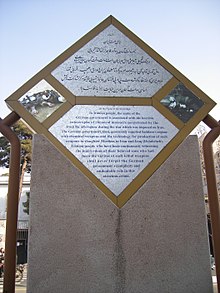
Commemorative plaque in front of the German embassy in Tehran, as a reminder of the chemical weapons deliveries from Germany
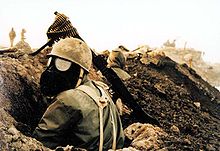
Iranian soldier with gas mask
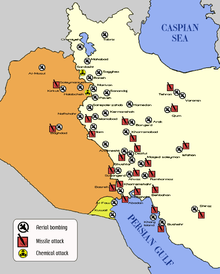
Map of air raids on cities

Iranian child soldier
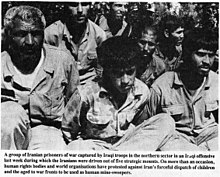
The Iraqi counter-offensives, which reached deep into Iranian territory in July 1988, were aimed at taking as many prisoners of war as possible before the cease-fire began to take shape, and these prisoners were to serve as leverage in subsequent peace negotiations.
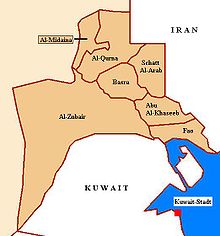
Basra Province
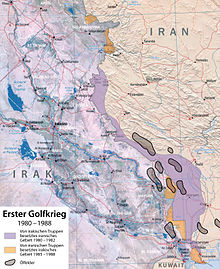
Front lines in the First Gulf War

Iraqi prisoners after the recapture of Khorramshahr
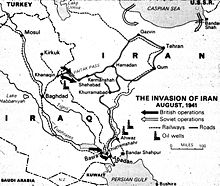
Map of the Anglo-Soviet Invasion of 1941
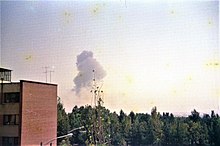
First Gulf War - 22 September 1980 - Tehran
Military confrontations with other states
Osirak
On June 7, 1981, an Israeli air strike with eight F-16 fighter planes took place against the Iraqi nuclear reactor under construction in Osirak, killing a French technician. Israel justified the strike against Iraq by claiming that it was a preventive measure against Iraq's nuclear weapons program, since Israel suspected the reactor to serve less for civilian power generation than for the construction of an Iraqi nuclear weapon. To this day, it remains unclear whether the reactor was intended to serve civilian purposes or military ones as well. The Israeli air strike against the construction site of the Iraqi nuclear reactor Osirak was judged to be a clearly illegal attack under international law.
→ Main article: Operation Opera
Tanker War
As early as May 21, 1981, a Panamanian-flagged tanker was sunk. After an Exocet missile hit the Iranian offshore field Nowruz on March 2, 1983, in an attempt to internationalize the conflict and prevent Iran from exporting oil, the so-called tanker war began.
Ninety percent of it involved Iranian oil, and at least 250 tankers were damaged or destroyed in the course of the tanker war. On May 14, 1988, it hit the largest oil tanker in the world at the time, the Seawise Giant, which was severely damaged by the Iraqi Air Force. Specifically, there were attacks on 45 ships by the end of 1983, 67 attacks in 1984, 105 ships attacked in 1986, and 34 ships attacked by May 1987.
The attacks against Iranian oil loading points (including Bandar-e Khomeini and Bandar-e Mashur) and tankers were carried out by the Iraqi Air Force mainly with the Super Étendard aircraft equipped with Exocet sea target missiles delivered by France in mid-1983. Iranian attacks against ships believed to be carrying Iraqi oil were carried out with naval mines, guided missiles and naval gunfire by Iranian frigates. The dangerous stretch between Charg Island, used as an oil terminal, and Larak Island off Bandar Abbas was nicknamed "Exocet Alley" among sailors.
The tanker war caused Iranian exports to drop to 700,000 barrels per day in early 1984, only to rebound to 1.6 million barrels by mid-year. In 1985, the tanker war resulted in a drop again to 750,000 barrels, against a 1982 peak of 3.2 million barrels and 1980 average production of 1.2 million.
Iraq, whose production facilities had already been attacked and destroyed by Iranian warplanes in late 1980, especially those near Basra, Kirkuk, and Mosul, saw its original total production of 5.2 million barrels per day drop to 1.9 million barrels. After Syria, one of Iran's few allies, banned the flow of Iraqi oil through its territory on April 10, 1982, Iraq's export volume was reduced to 600,000 barrels per day. The Gulf Cooperation Council, hastily formed in part because of the Gulf War, stood by Iraq in the loss of its oil revenues and provided Iraq with $50 billion in loans and gifts. Iraq spent 60 percent, Iran 43 percent of its budget on warfare (Fürtig, pp. 68/90).
US intervention
Continued attacks on international tanker traffic led to a strong U.S. presence. After Kuwait requested protection for its tankers in 1986, the US reflagged eleven tankers and now sailed escorts for the now US ships in Operation Earnest Will. Iranian ships had previously attacked Kuwaiti tankers, and Iran threatened a naval blockade in the Strait of Hormuz, although this was considered implausible as it would also have hit Iranian exports to a considerable extent. An Iraqi missile attack on 17 May 1987 on the frigate USS Stark (FFG-31) killed 37 US sailors. After the USS Samuel B. Roberts (FFG-58) ran into an Iranian naval mine on April 14, 1988, injuring 10 sailors, the United States launched Operation Praying Mantis beginning April 18, 1988, which resulted in the destruction of two Iranian oil platforms and several ships. At the same time, Iraq recaptured the Faw Peninsula.
→ Main articles: Operation Earnest Will and Operation Praying Mantis
downing of a passenger aircraft
As early as July 15, 1987, an incident occurred. Two Iranian passenger planes, Iran Air Flight 1251 and 1253, en route to Mecca, were targeted by American warships at 11:00 and 11:04 a.m. local time and received several shoot-down warnings. Iran considered this a "flagrant violation of international law".
The shooting down of the Iranian passenger plane with flight no. IR655 by the cruiser USS Vincennes (CG-49) on 3 July 1988, in which all 290 passengers and crew were killed, also contributed to the adoption of UN Resolution 598 on the Iranian side.
→ Main article: Iran Air Flight 655
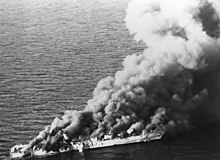
Aerial view of the burning Iranian frigate Sahand on April 18, 1988.

Tanker Routes and Prohibited Zones in the Persian Gulf
Questions and Answers
Q: What was the Iran-Iraq War?
A: The Iran–Iraq War was a war between the armed forces of Iraq and Iran lasting from September 1980 to August 1988.
Q: When did the war begin?
A: The war began when Iraq invaded Iran on 22 September 1980, after a long history of border disputes and after Iran demanded the overthrow of Saddam Hussein's regime.
Q: How many casualties were there in the conflict?
A: About a million soldiers died, and a similar number of civilians.
Q: What measures were taken by both sides during the conflict?
A: Both sides used blockade, which other countries opposed.
Q: How did international powers become involved in this conflict?
A: The role of the United States and Soviet Union was vital, dating back to the Cold War. In 1953, the US encouraged a coup d'état against Mohammad Mosaddegh, who was the Prime Minister of Iran. Shah Mohammad Reza Pahlavi returned to power, supporting his military and his government. The United States sold many weapons to the Shah's government. Meanwhile, revolutionaries of the Arab Socialist Ba'ath Party overthrew the king of Iraq and, with help from Soviet Union built up their army. Starting with United Arab Republic they sought to unite all Arabs into one state including Arab minority in Iran. After war started (especially between 1983 and 1988) US sold weapons to Iraqis mainly due to America's interest in containing revolutionary Ayatollah Khomeini thus both Soviet Union & US supplied Iraq with weapons against Iran .US had sold many weapons to Iranians before war it is believed that soviet union was selling weapons to both sides during war .
Q: Was there any resolution or end date for this conflict?
A: Despite several calls for an end to fighting by UN Security Council , two countries fought until 20th August 1988; last prisoners of war were exchanged in 2003 .
Search within the encyclopedia